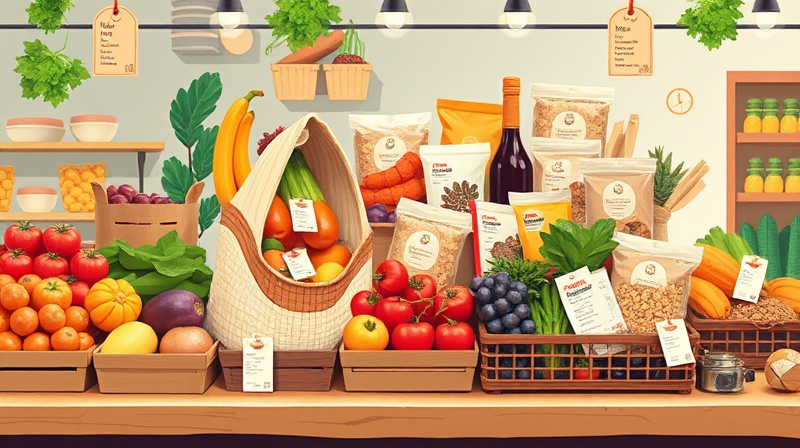In today’s economy, being smart about your grocery shopping is not only a way to save money, but also a pathway to a healthier lifestyle. With rising food prices in 2025, taking control of your grocery routine by designing a strategic list is more important than ever. By planning ahead, assessing what you have, and prioritizing quality alternatives, you can significantly reduce your expenses while enjoying nutritious and tasty meals.
The first step in crafting an efficient grocery list is to get organized. Far too often, trips to the grocery store end in overbuying, impulsive purchasing, and ultimately, wasted food and money. Instead, consider this process as an empowering routine that puts you in control of both your kitchen and your budget.
Plan Your Meals
Planning your meals is the cornerstone of cost-effective grocery shopping. Every effort you put into laying out your weekly menu has a direct impact on how much you spend. By knowing exactly what you need, you avoid purchasing items that will soon end up forgotten in the back of your pantry.
Start by browsing weekly store ads and take note of the discounts and sales available. This approach not only sparks meal ideas but also allows you to adapt your plan around the best available deals. Creating predictable meal routines, such as designating certain days like taco Tuesdays or pasta Sundays, helps further in planning and simplifies the shopping process.
Additionally, consider including "clean-out-the-fridge" meals in your plan. These are meals specifically designed to utilize leftovers and items already present in your kitchen. This strategy minimizes waste and reinforces the habit of reusing ingredients, saving you both money and resources.
Take Inventory and Embrace Store Brands
Before you even think about penning down a grocery list, conduct an inventory of your pantry, refrigerator, and freezer. This simple step prevents duplication of items and encourages better utilization of what you already have.
Embracing store brands is another savvy tactic. While name brands are popular, many store brands produce similar quality goods at a fraction of the price. By making a conscious decision to opt for these alternatives, you could see a significant decrease in your weekly spending.
Prioritize Whole Foods and Seasonal Produce
Focusing on whole, unprocessed foods not only enhances your health but also reduces overall costs. Processed foods often come with a premium price tag, despite their lower nutritional value. In contrast, whole foods like fresh fruits, vegetables, grains, and lean proteins are typically more affordable and beneficial for long-term wellbeing.
Seasonal produce is another great asset in your grocery strategy. Fruits and vegetables that are in season are not only lower in cost but also peak in flavor. When you shift your focus to what is naturally ripe and abundant, you ensure a fresher, tastier meal without breaking the bank.
Utilize Technology to Your Advantage
Technology plays a crucial role in optimizing your grocery shopping experience. Grocery apps and online tools can help streamline the list-making process. For example, price comparison apps give you the power to compare deals across different stores, ensuring you get the best prices available.
In addition to that, many grocery and meal planning apps offer digital coupons and allow you to integrate discounts directly into your shopping list. These tools provide an extra edge in monitoring your budget and finding hidden savings that might otherwise be missed.
Set a Budget and Include Non-Food Essentials
One essential tip for keeping costs low is to set a realistic grocery budget. Consider using budgeting principles such as the 50/30/20 rule where 50% of your after-tax income is allocated for essentials, including groceries. Establishing a concrete budget limits impulse buys and encourages deliberate spending.
It is also important to remember that groceries aren’t limited to food items only. Make sure your list includes necessary non-food essentials like cleaning supplies and paper products. Often, these items can be bought in bulk or chosen as store brand options, thereby contributing further to overall savings.
Review, Refine, and Commit to Consistency
After your shopping trip, take time to review your list and assess what worked well and what could be improved. Whether it was a surplus of unused items or the discovery of a new tactic for cutting costs, every experience adds value to the process. Regularly refining your list and adapting your strategies is key to continuous improvement in managing both food waste and household expenses.
Remember, the goal is not just about spending less, but also about making smarter choices that lead to a balanced lifestyle. By committing to a consistent approach in meal planning, inventory management, and budgeting, you can transform your grocery shopping into a disciplined, cost-effective, and enjoyable routine.
In conclusion, designing a grocery list that truly cuts costs requires a methodical approach—one that involves planning meals, assessing current supplies, utilizing technology, and being mindful about every dollar spent. Every small adjustment counts and the cumulative effect over time becomes a substantial saving. Embrace these steps with enthusiasm and watch your savings grow while still enjoying delicious, nutritious food.








